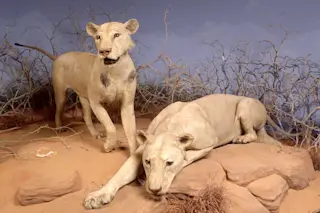What's left of the notorious lion duo known as the man-eaters of Tsavo now resides at Chicago's Field Museum. (Credit John Weinstein, The Field Museum) The man-eaters of Tsavo, two lions that killed railroad workers in Kenya more than a century ago, have inspired legends, movies and a lot of research papers trying to explain what drove the big cats to prey on humans (a rare menu choice for Panthera leo). A study out today finds that, in one crucial way, the infamous killers were a lot like — surprise — zoo animals. For years, the true story of the man-eaters of Tsavo has been embellished and exaggerated, most recently in the 1996 movie The Ghost and The Darkness. Historically, what we know for sure is that over a nine-month period in 1898, two maneless male lions (maneless being the status quo for lions in the area) killed several workers ...
Infamous Man-Eaters of Tsavo Ate Like Zoo Animals
Explore the mysterious behavior of the man-eaters of Tsavo, two infamous lions that hunted railroad workers in Kenya.
More on Discover
Stay Curious
SubscribeTo The Magazine
Save up to 40% off the cover price when you subscribe to Discover magazine.
Subscribe













